Leather is a huge subject especially for beginners in shoemaking . There are a lot of leather types you can work within making shoes, and it depends on what shoe type and shoe design you want to make, what shoe construction you prefer to make, etc. But there is best leather types for beginners in shoemaking, to not fall down in encountering extra difficulty with certain leather types that are hard to work with for beginners in shoemaking.
So to help you with this big subject I want to give you my suggestions on what leather types you can start to work within shoe making, if you are a total beginner and just started making shoes. Also I would recommend to read this post: "Beginners in Shoemaking Tools and Materials Definitive Guide 2023" if you want to learn about entire shoemaking process.
We will start with vegetable-tanned leather because you can use it in making most of the shoe parts:
Maximizing Vegetable-Tanned Leather in Shoemaking: Top 5 Applications
1. Shoe Insoles: Finding the Right Leather for a Comfortable Fit

I already wrote a post about leather insoles, how to work with leather insoles, and why leather is the best material to make your shoe insoles from. If you missed it, you can check this post “How to Make Bespoke Shoes From Home [with me]”
2. Structural Stiffening: Leather Types for Robust and Elegant Shoe Shapes
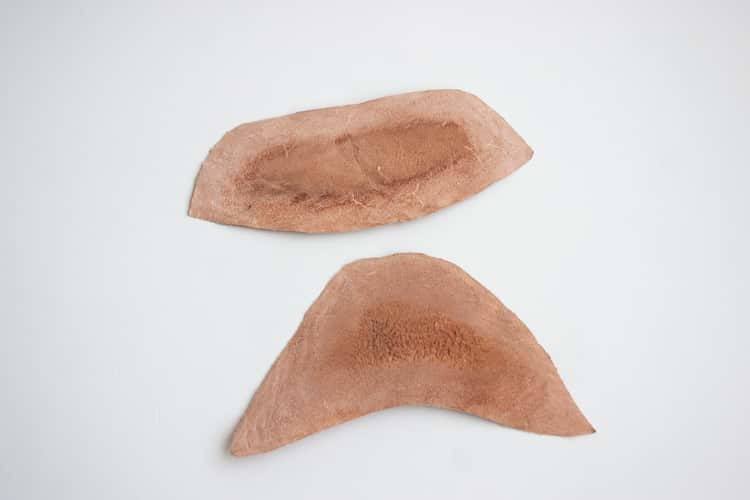
3. Professional Guide to Selecting Leather for Shoe Soles: Durability and Comfort

There are many different shoe sole types you can create in shoe making but working with leather insole making you will have many different design options. Continue reading this article and I will give you a few examples of leather shoe sole designs you can make in your craft.
4. Heel Support: Selecting the Right Leather for Sturdy and Stylish Heels
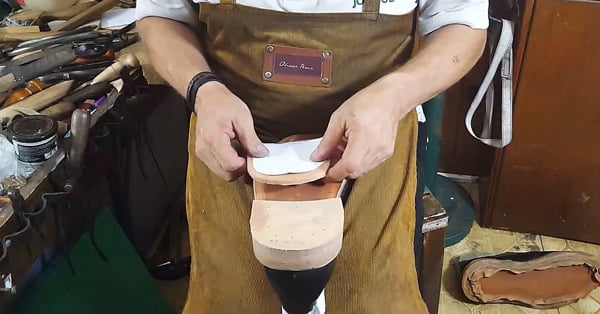
If you are a beginner in shoe making you should know that one of the important things In making heels is the right heel height calculation. So in this post “How To Make Heels and Heel Height Calculation” you can learn this important shoe making approach together with the mistakes that come with wrong heel construction.
5. Upper Aesthetics: Vegetable-Tanned Leather for Elegant and Durable Shoe Uppers
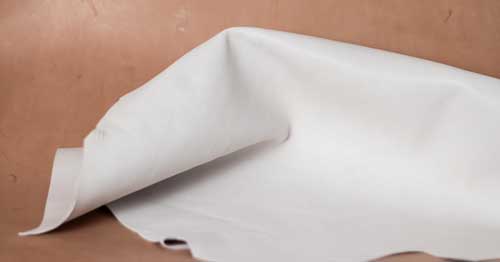
In bespoke shoe making it is a very useful material because a bespoke shoemaker can color it how he wishes, can create different color effects, and apply patina.

Only from this short explanation, you can understand how veg tanned leather is valuable for you in your shoe making craft.
Creating Stunning Shoe Uppers with Vegetable-Tanned Leather
I will not talk here on how veg tanned leather is made because there is a tone of this information and some of them you can find in this article “What is vegetable tanned leather “
Disclaimer: This is not an advertisement. They have a lot of different leather types to work with.
They also sell different types of leather that are good for beginners in shoemaking, so you can find here materials to start making shoes.
There are different veg-tanned leather types with the different thickness you can use and each of them suits for different shoe parts.
For different shoe parts, we use veg tanned leather made from different parts of the animal hide. I will not talk about it here, there is a lot of info about parts of the hide, as this short article “Parts of the hide”.
So let’s learn what leather type you can use for different shoe parts.
1. Creating Leather Shoe Insoles: Essential Know-How for Beginners
For the shoe insoles, we need to have flexible and not durable leather. That’s why the shoulders are the best part of the hide for this shoe part. This leather type is good as for beginners in shoemaking as for experienced shoemakers.

There is a difference in the thickness of the leather insoles for women and men's shoes. I talk about it in the shoe making tutorial I prepared for you ( you will find it here, scroll down)
What is important in making shoe insoles is to use steel shanks especially if you want to make high heels women shoes. You can read more about it in this post “ Steel Shanks In the Insoles Construction”
2. Mastering the Art of Shoemaking with Leather for Stiffeneres: Tips and Techniques
For the leather stiffeners, you can also shoulders, and the thickness of this part is 2-2.5 mm.
You will need to skive all edges of the leather toe puffs and leather counters and leave the original thickness of the leather in the middle. This is how these inner parts of the shoes will be strong enough to keep the shape of the footwear and to protect your feet.
When I make shoes, I prefer to use leather stiffeners, because this material is so pleasant to work with and has many advantages, so this leather type is excellent for beginners in shoemaking.

If you don’t want to use leather in shoe making and check for the alternatives there is another material for the stiffeners you can use and it is non-woven chemical material that activates with tinner. If you want to know more about this alternative material for the leather stiffeners you can check it in this post “How To Work With Celastic Material In Shoemaking?”
You should know that to make stiffeners no matter from which material you want to, you have to make a pattern for stiffeners at first and in this post "How to Make Shoe Toe Puffs?" I teach it.
3. Best Leather for the shoe soles
For the shoe soles, we need to have strong leather and that’s why we use the back part of the hide (sole bends).
There are many different sole making techniques and you can learn all of them in this post "Best shoe sole making techniques[from beginners to pro]".

Usually, the thickness is 4-5.5 mm and it is perfect thickness to create hidden seam in the sole when you want to make shoes with welted construction. If you want to learn more about hidden seam, check this post.
For women and men shoes we use this type of veg-tanned leather but the approach is different.
In making men's shoes we can leave the original thickness of the sole bends.

Take a look at this bespoke Oxford shoes with welted construction we did in my English Welted Brogue Oxford Shoe Course.
In the making of the women's shoes, we need to skive the edges to create an elegant look of the women's shoes.
You can skive the entire surface of the leather for soles, like in this example
Or you can skive only on the edge of the sole.
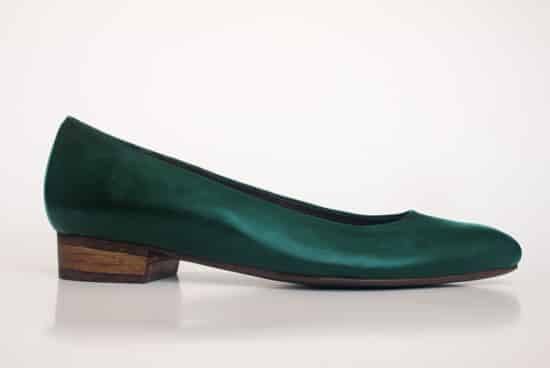
Working with leather soles you have many different options in order to make shoes with interesting sole designs that will suit the design of your shoes.
For example, you can create double leather sole as we did in my “Moccasin shoe course”
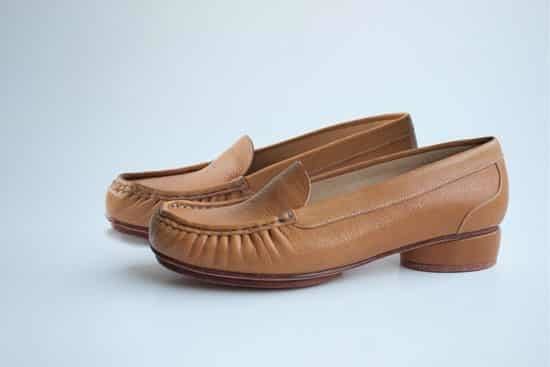
Also if you want, you can leave the original thickness of the sole bands in making women shoes with welt, for example. See how we did it in my “High heels PumpShoe Course”.
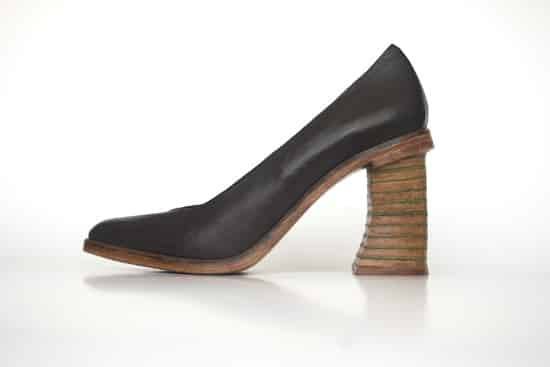
4. Leather for the heels

To make beautiful and strong heels you should use the same type of leather that we use for sole making- the sole bends.
It will add extra weight to your shoes but it's worth it.
Selecting the Right Leather for Shoemaking
Now, let’s talk about leather types for the shoe upper you can work within making your shoes especially if you are a beginner in shoe making.
I decided to create a short video tutorial (in the end of this post) where I mentioned the best leather types that I recommend for you as a beginner in shoemaking. You can try your luck and ignore my suggestions but this kind of frustration can break your desire and passion.
Before you will dive into my tutorial, I decided to list here types of leather that I recommned to avoid at least in the begining
Choose wisely.
Avoiding Leather Selection Pitfalls in Professional Shoemaking: A Guide for Beginners
Now, why you should avoid those types of leather at least at the beginning of your shoemaking learning:
1. Patent leather may crack during lasting, especially, if you work using pointed toe shoe last.
2. In the process of folding patent leather it also may crack, if you don’t know how to work with it. You have to know, how thin you need to skive the edge of the patent leather to fold it.
The main reason for the cracking in the patent leather is that usually for patent leather they use a split leather (a second layer) that just covered with the liquid material to create a patent leather. It’s not a rule, but when leather has some print or patent surface that means that this leather was scratched, had some spots, made from the hide of old animal.
3. The main reason why it is better to not use a suede leather and nubuck leather is that during all the steps of shoemaking; like cutting, sewing, lasting and sole making, it is very easily to get it dirty. You will need to know how to clean it. The bad news are, that sometimes it’s impossible.
There is a special plastic cover ( shoe bag) made to protect your upper leather from getting dirty during the lasting process, but for you, as beginners in shoemaking, I don’t recommend to work with it at least in the beginning of your shoemaking progress.
In my shoemaking tutorial about leather types to work with in shoemaking I didn’t mention many other different leather types like sheepskin leather, kangaroo skin leather, horse skin leather, and many different exotic leather types for many reasons:
1. Sheep skin leather - many people may be allergic to it.
2. Kangaroo skin is a wonderful leather for boots as it is very strong leather and durable, this is the reason why at the beginning of your shoemaking progress it is better to not use it.
3. Horse skin leather is also durable.
4. Exotic leather types like crocodile skin, snakeskin, fish skin, and many others are very expensive! So until you will have good shoemaking skills don’t waste your money.
Work with other leather types that I mentioned in the tutorial.
Now let me know in the comments below what types of leather you use in your work?


Thanks Sveta, I can confirm nubukleather is not good … no, no, no….I started with a packet of rest leather and it was nubuk. ( Beautiful though). When lasting my first shoes I made all mistakes a person can make … And I spoiled this nubukleather with the thinner for my stiffeners. And I fiddled with the glue, and made scratches when sanding the outsole…. I was in tears!!! Recovered though from the drama 😉 Happy shoemaking to all of you Cheers Kristine
Thanks for sharing Kristine. The good thing is that you already have this experience.
I feel so happy to found this page. Thank you and God bless you
Ooh my Gosh thanks for this knowledge, I have been using these pattern leather suffering with it and don’t understand what was not ok. Thanks I will watch out no
Vivian, you are doing a good job, keep on doing that.
Thank you Sveta this is really good basic information, I love working with printed and pattern leather but did not realise how dirty it can get and found it hard to clean.
Thank you for all your videos they are so so helpful
That is great, thank your for your comment
Thank you Sveta for this really helpful article – it’s especially useful because you don’t simply advise against using a particular leather type, but you give all the reasons why; I hadn’t realised just how grubby and bashed the leather can get during all the working processes, so the advice to avoid suede/nubuck is definitely good advice. I would add from my own experience, that buying cheaper “seconds” leather isn’t necessarily a good idea either – I did exactly that, as I reasoned that being a beginner, I might well make loads of mistakes, and I didn’t want to waste decent materials – the colour wasn’t consistent across the whole skin, so a proportion of it wasn’t useable anyway, and it marked very easily, which caused me no end of headaches!
Thank you Sveta for this really helpful article – it’s especially useful because you don’t simply advise against using a particular leather type, but you give all the reasons why; I hadn’t realised just how grubby and bashed the leather can get during all the working processes, so the advice to avoid suedeundefinednubuck is definitely good advice. I would add from my own experience, that buying cheaper “seconds” leather isn’t necessarily a good idea either – I did exactly that, as I reasoned that being a beginner, I might well make loads of mistakes, and I didn’t want to waste decent materials – the colour wasn’t consistent across the whole skin, so a proportion of it wasn’t useable anyway, and it marked very easily, which caused me no end of headaches!
how many leather is used for instance a loafer, I am really interested and need it for a big school project
May I ask where I can find sole bend leather in small quantities? I’m just starting with a singe beginner pair and I cannot afford to get the whole giant piece for 100+. I only need two 4.5×11 pieces. I have been able to find offcuts of most other leathers, but not of sole bend. If you know where I might get sole bend offcuts I would highly appreciate it.
Search online for leather stocks or locally, depends where are you from.
What should be the upper n lining thickness for men shoes? Thanks
Hello! I did a lot of research before I ordered anything. For my soles I ordered veg tan leather 6mm thick from Italy.
For the upper (Cowboy boots) I ordered regular cow hide, but it's stamped and has a floral design. I'm putting zippers in as this will be a fitted boot hugging my legs, inspired by an existing pair.
I'm ordering lining too but have not yet done so. From research though I see that it should be thinner & I want something with a print or cool design.
There are still several parts I need, steel shanks
And I got my shoe lasts from a place in Russia.
But before I cut anything I'll make a mock pair in muslin 🙂
Do you teach cowboy boot making classes too?
Sveta Kletina thanks for sharing such valuable information with us. In fact, I was searching for types of leather and have a plan to purchase a leather jacket and shoes. In research, I came to this page and you addressed all my queries quite well. Now, I have an idea, which leather suits my body and personality. Thank you so much
Great comment, tnx